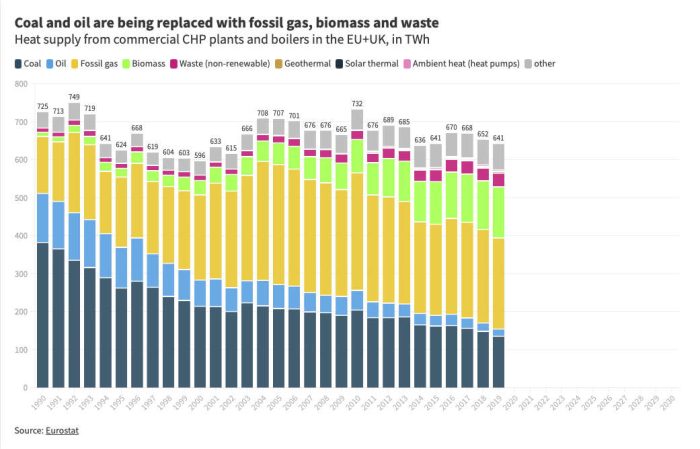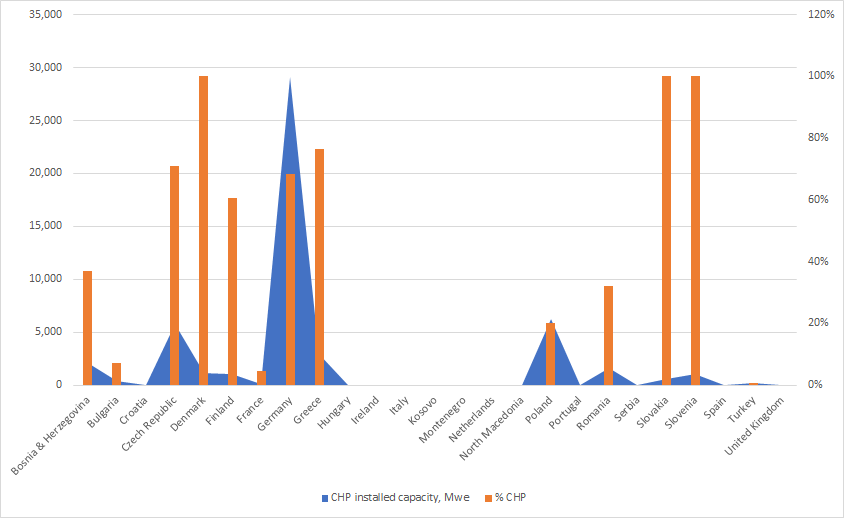COMBINED HEAT AND POWER AND DISTRICT HEATING
Coal’s future as a source of electricity is not only coming to an end, its role in district heating systems across Europe is also changing rapidly as cities act on the climate and health crisis – and the same needs to happen soon for fossil gas. Just like power plants, all coal-fired combined heat and power plants have no future beyond 2030, and must be replaced by sustainable and renewable alternatives, while also beginning to rapidly phase out fossil gas from heating grids.
To limit average global temperature rise below 1.5 degrees Celsius and secure a zero pollution future, district heating systems across Europe need to be totally defossilised and cleaned up, this decade for coal and fossil gas soon thereafter. Converting from coal to gas is just swapping one unsustainable fossil fuel for another, instead of transitioning to a sustainable renewables-based heating system.
Fundamentally: we have to stop burning fuels. Municipalities which already rely on fossil gas or unsustainable biomass for heating must also plan their replacement with a mix of renewables, efficiency and ‘system change’ measures, in order to protect the health of their residents and prevent disastrous climate events.
A combination of many options exist to source heating from renewables, while transforming our heating systems overall, including through electrification through for example heat pumps, geothermal, and solar thermal capacity. The district heating infrastructure itself, if renewables-based, is a key solution to changing how we heat our cities and homes overall – we are going to have to see a massive modernization and expansion of heating grids across Europe. While doing so, a strong focus on increasing energy efficiency for much lower heating demand is a pre-condition
Overall transitioning to renewables-based district heating will bring significant benefits to health, jobs, air quality, and our climate.
DECARBONISING HEATING
An important step towards decarbonising the heating sector is the shift from the dirty, old coal installations to green district heating and energy efficiency. Europe needs to focus on clean, affordable, efficient and climate-safe heat and power. To get there, state aid subsidies for fossil fuel based combined heat and power (CHPs) should become illegal, and governments and policy makers should ensure that funds are channelled to sustainable heating solutions instead. We need to make sure that there will be a clear phase out plan for coal and fossil gas, and that significant action will be taken to strengthen renewable energy in district heating, thereby contributing to the goal of Europe going 100% renewable in energy by 2040.
RELATED CONTENT

Efficient district heating in CEE countries

Sustainable alternatives for coal in the heating sector
DATA & FACTS
The main fuel that is being used in district heating systems across Europe is fossil gas. Although its use peaked around 2010, for the past decade it remained constant. Coal, meanwhile, declined steadily, and it is possible to safely eliminate it by 2030 across Europe. Unfortunately, most of it was replaced by new biomass installations, particularly in the Nordics. At the same time, the deployment of sustainable renewable solutions was not as rapid: today they represent only 1% of the European supply structure.

Energy supply structure in European DH grids in TWh/a
There are more coal CHP plants in Germany than in the EU, Western Balkans, and Turkey combined: in December 2021, there were 48 plants totalling 29 GW installed capacity in Germany, out of the 136 plants at European level, which have a combined installed capacity of 52 GW. Germany, one of the world’s largest economies, still relies on the 19th century’s fuel to heat a large part of its population, but thankfully it’s new governing coalition aims to exit coal completely by 2030. However, it has yet to position itself on fossil gas, against its overall 2045 climate neutral target for the countries and all sectors. This sets the stage for a broader debate that will be needed to transition to truly renewable-based heating systems across Europe.
After Germany, Poland and the Czech Republic have the largest coal-based CHP fleet in Europe, with around 6GW each. While CHPs are only a fifth of coal power plants in Poland, in Czechia and Greece they represent the majority, while in Denmark, Slovakia and Slovenia, all operating coal power plants are CHPs.

Installed capacity in coal combined heat and power plants, MWe, left, and the percentage of coal CHPs from the total number of coal power plants. Data: Europe Beyond Coal
FALSE SOLUTIONS
Fossil gas
Although most district heating systems in Europe already use fossil gas, a polluting and expensive fuel which is prone to violent price spikes and geopolitical shifts, some governments still plan to build more gas infrastructure. This is not only in direct contrast with climate commitments, but leaves them vulnerable economically and politically. Fossil gas is being positioned as a transition fuel, but it still emits large quantities of carbon dioxide when burned, and it comes with the massive methane leakage problem throughout its life cycle, which is a very potent greenhouse gas. We have to make better choices, and replacing one fossil fuel with another fossil fuel is not a smart move when there are far better alternatives available.
Biomass
Bioenergy is often viewed as a more “natural” form of energy, but it comes with its own set of problems. If certain conditions are not met, it can actually increase greenhouse gas emissions, trigger land use conflicts, and lead to deforestation, forest degradation, biodiversity loss and air pollution. Continuous subsidies for bioenergy can distort renewable energy and raw material markets, while undermining efforts to use limited resources more efficiently in a circular economy.
There is very limited space for biomass in an energy transition process that meets climate, biodiversity, and zero pollution goals, and with virtually every source of energy that involves burning something: there are almost always better solutions available.
ALTERNATIVE HEAT TECHNOLOGIES
Heat demand reduction is key The most important measure to tackling the heating challenge is the reduction of demand via energy efficiency measures, particularly in existing buildings. Reducing heat energy demand is key to reducing peak demand and bringing down the cost of decarbonisation. But most importantly, a lower heat demand is necessary because sustainable heat supply is usually limited and can meet demand best if it’s low. The Heat Roadmap project recommends overall demand reductions of approximately 30-45 percent of current levels. The “Paris Agreement Compatible Scenarios for Energy Infrastructure” (PACS) even assume demand reductions of nearly 70 percent.
Energy efficiency also facilitates the reduction of operating temperatures in the distribution grid, which in turn is necessary for the integration of a range of renewable energy sources. Furthermore, energy efficiency enables more house connections to the existing district heating grids without changing their capacity.
Deep geothermal energy is a dispatchable, clean, renewable and carbon-free energy source with low space requirements and a significant potential in urban areas. In recent years, technological learning has led to cost reductions. Yet, the technology still suffers from low prices and subsidies for fossil fuels. Geological uncertainties come on top of this. They are due to the low level of resource exploration in many regions of Europe, which leads to a low number of concrete projects. [Click to expand for more]
However, the technology characteristics make geothermal energy generally very attractive for decarbonised district heating grids. If a general potential is known or suspected to exist, municipalities should further investigate if it can be exploited. National governments are advised to create favourable conditions for this mature technology, in particular by reducing the geological uncertainties.
Further reading:
Information portal Think Geoenergy
Geothermal energy: Opportunities in Eastern Europe
Geothermal energy applied in Hamburg, Germany
Solar thermal energy is a cost-competitive, clean, renewable, and carbon-free energy source that is well-suited to supply heat to district heating grids. The technology plays out its full-scale strength when built as a large collector field. Such applications exist, primarily in Denmark, but also in Austria, Germany, and Poland. With better market conditions and enough space available, the technology is ready to grow significantly. Without seasonal storage, up to 20 percent of a municipality’s space heating demand can be provided by solar thermal energy. When seasonal storage is included, as much as 50 percent and more is possible. The high space requirements and the need to produce heat in proximity to consumers reduce the potential, in particular in densely populated areas, but there are ways to deal with these challenges (e.g. multi-uses of the area).
Further reading:
Solar District Heating Initiative
Brochure about Solar District Heating solutions
Multi-use options for solar thermal energy [DE]
Electrification is another important element of the transition of the heating sector. This can either happen via resistance heaters, i.e. large-scale kettles, that turn electric energy, ideally surplus renewable electricity, into heat. The second and more important route is via small and large-scale heat pumps. Heat pumps use electric energy to make ambient energy from low-temperature fluids (air or water) available for heating by “pumping” (lifting via compression) the temperature of the energy carrier to a higher level. This process, also known as a “reverse fridge”, is about two to four times more efficient than resistance heating, but requires a local heat source. Large-scale heat pumps usually require a water-based heat source like a river, a lake, sea water, or sewage or mining water. As an alternative, waste heat from exhaust gasses of industrial processes can also be used. If such a heat source exists, heat pumps are very valuable for the decarbonisation of heat. This technology can be cheaper than heating with gas with relatively low levels of carbon pricing.
Further reading:
Large-scale electric heat pumps in district heating systems
Large-scale heat pumps in Swedish district heating systems
The decarbonisation of the EU heating sector through electrification: A parametric analysis
Waste heat recovery does not refer to the burning of waste, but to excess heat that originates from small or large-scale industrial processes. Exploiting this source is among the most efficient ways of using energy and can contribute another puzzle piece to decarbonising the heating sector. The energy itself comes at no extra cost, but it has to be integrated into the existing district heating grid, which often requires the installation of new pipes. The utility and the heat provider also need to make arrangements about the feed-in structure, which is a highly individual process. In some cases, the temperature level of the fluid needs to be increased via heat pumps to enable feed-in.
Further reading:
Quantifying the excess heat available for district heating in Europe
Preliminary assessment of waste heat potential in major European industries
Integrating renewable and waste heat and cold sources into district heating and cooling systems

